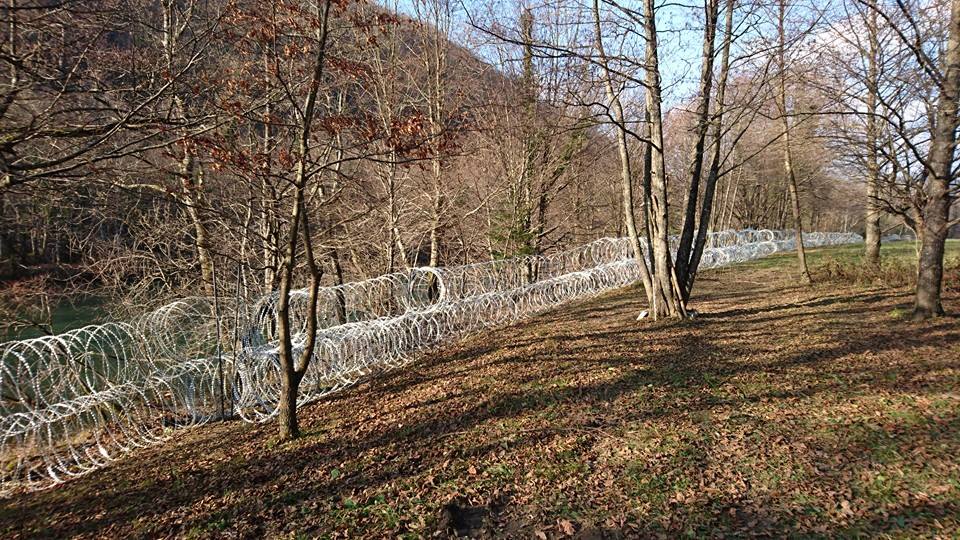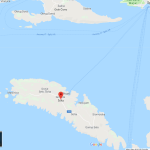Looking for safe, authentic lifestyle experiences on holiday and away from the coast? Meet the outstanding offer of Croatian rural tourism. A regional guide.
- Introduction to Croatian rural tourism
- Eastern Croatia – Slavonia
- Northern Croatia
- Central Croatia
- Lika
- Kvarner
- Istria
- Dalmatia
Introduction
Croatia is famous for its sunny coast and wonderful beaches, rich cultural heritage in medieval cities and great food. However, there is a hidden side of Croatia still waiting for you to discover. Over 90% of Croatia’s territory is rural and more tourists are exploring opportunities to experience a different Croatian holiday. But rural Croatia is a still a mystery as there are scarce resources which could guide tourists to exploration. Forget about road signs – there are very few so you are likely just passing by when driving on beautiful highways. The signs are almost non-existent and internet information in foreign languages is short supply. If you decide to get off the highway or have a special vacation in rural Croatia – we hope this article will be at least somewhat helpful.
So what you can actually do in rural Croatia?
If you are a nature lover, good news for you. Eight national parks and 12 nature parks (see a Guide here) , and plenty other natural beauties are waiting for you. Getting there without car is a challenge, but you can rent one, or simply book a tour. The good news is that there are road signs for all protected areas. So if you are passing by don’t miss the opportunity to visit them. The clear waters, remarkable landscapes, and flora and fauna will amaze.
Should you need some adrenalin boost at your vacation, there are plenty opportunities. Hiking, rafting, kayaking, canoeing, sailing, bungee jumping and other adventures waiting for you to discover beautiful sceneries. The same is true for cycling. Marked routes in all parts of the country combine with a growing number of rental agencies and bike&bed options.
Perhaps the best way to know the country is to learn about its culture and cuisine. Therefore, before you start exploring rural Croatia, learn some important words. For many signs on the road might only be in Croatian. Also, agricultural estates, the best places for wine and food tasting may display in different ways, starting from brown signalisation to simple signs made by their owners. Follow the signs for OPG (family agricultural estate), agriturizam (agritourism), seoski turizam (village tourism), vinarija (winery), kušaona (tasting place), izletište (excursion site), and etno selo (ethno village) for your magical experience of rural Croatia.
Croatia’s rich cultural heritage is only partially visible in cities. Rural areas are a cradle of Croatia’s culture as many lesser-known cultural sites are all over the country. Almost every village has an old church or a monastery worth paying a visit. And there are many ethnographic exhibitions and museums which can give you a good sense of what Croatia once was.
Croatian rural tourism – Croatia as it once was
And that is a slogan which rural Croatia is still offering. The Mediterranean as it once was was the nation’s tourism promo slogan for many years. It is still valid for rural Croatia. Locals produce great wines including from over 130 indigenous varieties, rakijas, liquors, and home-made juices, extraordinary cheeses and meat products such as prosciutto, ham and sausages, some of the best olive oils in Europe and are proud owners of biggest truffles in the World. Fresh fruits and vegetables, and grains are staples to serve delicious foods prepared using old recipes passed from one generation to another.
Locals also care about preserving rural architecture and customs, such as a welcome drink. Do not refuse, your hosts would consider it rude. Plus, after spending some time in rural Croatia you can leave Croatia with a current slogan – Full of Life with an addition: Full of Countryside – if you decide to visit.
To help you in getting around, we will take you through a tour of rural Croatia by its regions.
Eastern Croatia – Slavonia
What is now Slavonia on tourist maps is actually Slavonia, Baranja and Western Syrmia. Bordering Hungary, Serbia and Bosnia and Hercegovina, this region is an absolute stop spot for all tourists coming to or from the coast through this route. Whether you simply want to take a break from driving or decide to relax after spending some time on crowded beaches, this could be a good option. You can almost forget about hotels in rural Slavonia, but there are plenty rural estates offering accommodation in nicely preserved ethno rooms.
In terms of natural beauties, a visit to Nature Park Papuk – Croatia’s first geopark, or Nature Park Kopački rit in Baranja – one of the best-preserved floodplains in Europe are a must. The first one is one of the oldest mountains in Europe dating as back 500 million years. Backthen, it used to be an island in the Pannonian Sea. So, if you love hiking and adrenaline (don’t miss Adrenaline park Duboka), have had enough of Slavonia’s flat sceneries, and want to taste a river trout caught in front of your eyes – it is a place to visit.
Psunj, Dilj, Krndija and Požeška gora mountains also offer different recreational activities. When close to Papuk, don’t miss a visit to local wineries at Zlatna dolina (Golden Valley) and in Ferićanci. Kopački rit is the largest European wetlands, a natural triangle between the rivers Danube and Drava. It is also the largest internal delta of the Danube. A myriad of different tours is available daily – over 2,300 different species are worth paying a visit!
The oldest continuously inhabited town in Europe
Culture? There are many castles, churches, monasteries, and other interesting places to visit. Slavonia is home to the oldest city-like heritage site Vučedol which is a must if you are close to Vinkovci. Vinkovci is the oldest continuously inhabited town in Europe. Visit ethno village Karanac, where you can learn a lot about Croatia’s rich village history in the Street of Forgotten Times run by local agritourism Baranjska kuća. Besides the displayed etno collection, they take full care to preserve old recipes of this area.
Baranja specialities
Here you can taste the best of traditional Baranja’s appetizers such as ham, kulen, kulenova seka and čvarci from the indigenous black Slavonian pig, and famous dishes like fish-paprikaš – a stew made from local river fish, čobanac (meat stew), carp smoked on wood, or zander – king of river fishes – perkelt (type of goulash). Many are common throughout the region. Desserts to try include taškice, makovnjača (poppy cake), orahnjača (nut roll), pasta with jam or poppy seeds, and gingerbread. The hosts are likely to make your stay memorable accompanied by local tamburica players. After these rich meals, spend a night at wonderful ethno rooms at the estate or elsewhere in Baranja. There are plenty of accommodation options. Check our Baranja in a Page article here.
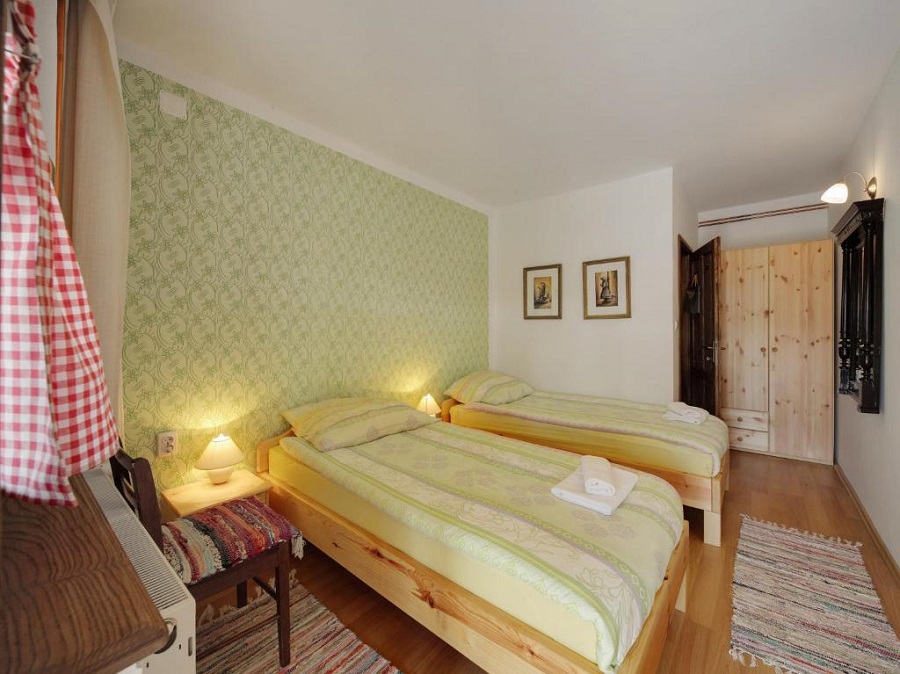
The largest quantities of Croatian wines are produced here. Rich and sandy soils make a perfect match with hot summers. But the quality resembles the quantity as wines are great across the region. If extraordinary wines are your thing, visit Zapadni Srijem (Western Srymia). Wines from this region were served at royal wedding ceremonies of Queen Elizabeth and Prince Harry. The biggest oak barrel is in Erdut, whilst Ilok wineries and a view from Principovac offer memorable experiences and great scenery of the Danube River.
Northern Croatia
When entering from Austria, Hungary, or Slovenia, you are passing through North Croatia. There are many unknown destinations waiting for you to discover such as Međimurje, Zagorje, Varaždin area, and Podravina.
Međimurje
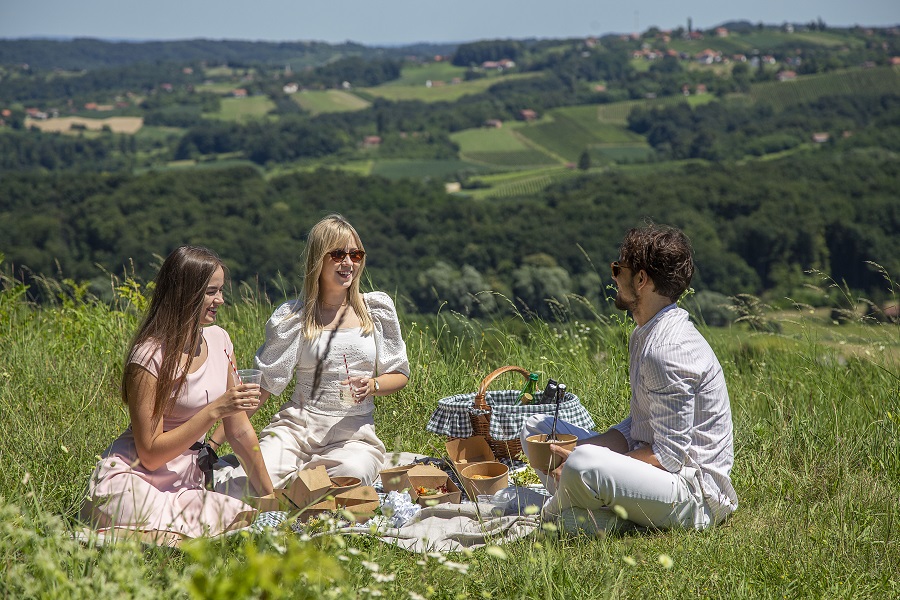
Međimurje always offers more! This is one of the most developed rural destinations of Croatia. Due to its famous wines, agriculture based on biodynamic Rudolf Steirer’s methodology and stylish rural accommodation such as Holiday Home Lina. This small wine growing region is already famous at Decanter for having the greatest number of medals per vineyard areas in Europe. A visit to Terme Sveti Martin, a world known spa and a first EU Eco label estate in Croatia is a must for all those wanting peace and relaxation. They are also famous for connecting local food producers with their gourmet offer. So if you are in the healthy food and great wellness – this is a place for you.
Međimurje is also famous for its 12 visitor centres displaying local heritage and natural wonders deriving from its rich Mura and Drava rivers and a first wine camp in Croatia located at agricultural estate – Wine House Hažić. When in Međimurje, there are plenty of restaurants such as Terbotz, Mala hiža and Međimurski dvori serving local dishes with weird names – pretepeno, kalapajsano etc. You certainly must try meat from tiblica. This is a traditional way of preserving meat in pig’s fat without a refrigerator. And a local dessert, tasty Međimurska gibanica which will not help you in losing any calories. Due to high season, you might want to reserve your table in advance. You can find more about this great destination in a Međimurje in a Page article here.
Podravina
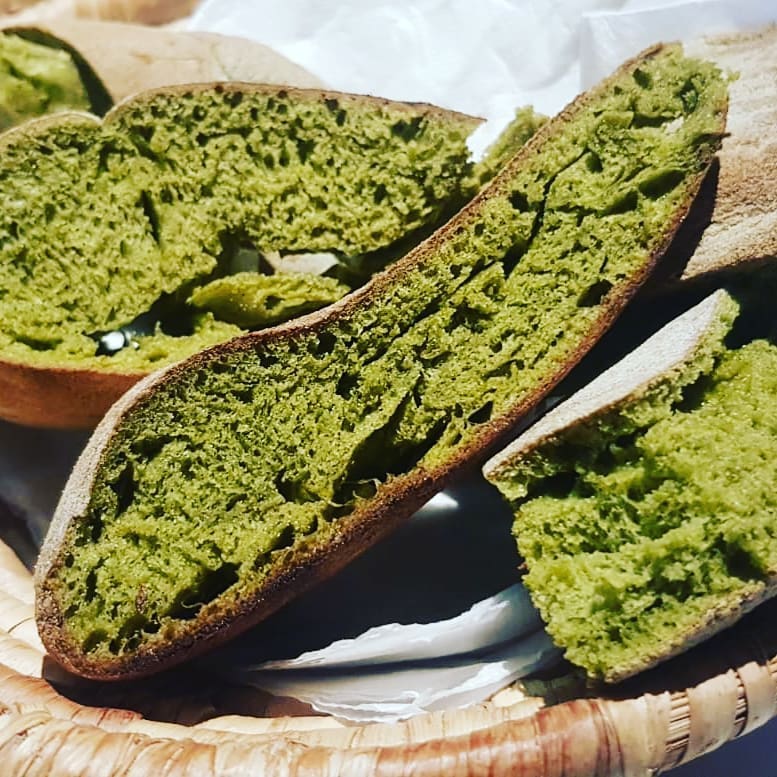
Podravina is less touristy, but certainly worth a stop. Bordering Međimurje and sharing the Drava river experiences, this mostly agricultural region offers one of the best local fruit and vegetables in Croatia. Driving through endless corn or sunflower fields offers unforgettable experience for all nature lovers. And the food taste is something you will never forget! Visit Zlatni klas Otrovanec agricultural estate which is open throughout the year. It offers interesting food combinations and accommodation in old barns. Have you ever tried nettle bread or pancakes? The nettle, with its numerous healthy benefits, is the basis of their kitchen. Apart from the two, they also make nettle juice, nettle pasta and soups. Pumpkin, barley and other grains, and a variety of meat from locally grown cattle on your plate will make you want to to take some for the trip as well.
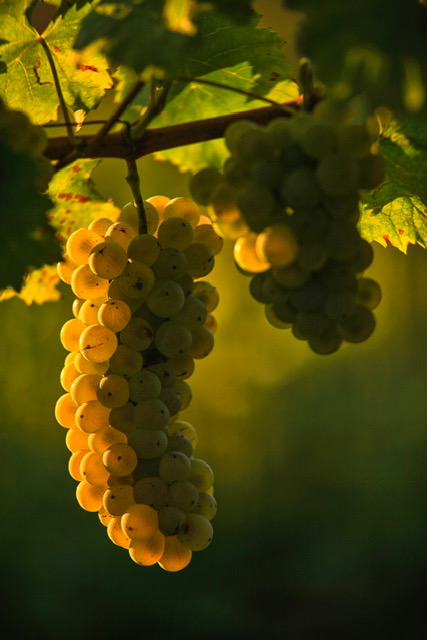
Although this is not a famous wine region, locally produced wines are getting more and more recognition for their quality. A wine tasting in Podrum Vineda is a great experience. For culture lovers, Hlebine, a home village to Croatia’s naive art offers a world known gallery. If you are into horse riding, you can enjoy it at Zlatni klas, or Pustara Višnjica.
Zagorje
Zagorje – a Fairy-tale at Hand! The Zagorje region is home to one of the biggest exhibitions of Neanderthal remains. There are castles, numerous thermal springs, and Croatia’s two ex-presidents Tito and Franjo Tuđman. The five Zagorje museums will satisfy all culture lovers. Krapina Neandartal Museum, Veliki Tabor Castle in Desinić, famous sculptor Antun Augustinčić Gallery in Klanjec, Museum of Peasant Revolts in Gornja Stubica, and etno Museum Old Village in Kumrovec where you can see Tito’s birth village and house provide a great insight into Croatia’s rich history from ancient to modern times.
Its thermal springs and spas are well known since Roman times as well as their castles and villages. You can treat yourself at Krapinske, Tuheljske, Stubica or Sutina thermal spas, or Jezerčica. Before that, visit some of the famous tourist areas and restaurants such as Vuglec Breg, Zelenjak or Grešna Gorica. Don’t miss tasting local specialties such as the famous Zagorje soup, and štrukli. Or turkey with mlinci – a local pasta, all pleasantly combined with good local wines. For nature lovers, a secret piece of information – the region has over 40 varieties of orchids. Most of them are on Strahinjćica mountain.
Varaždin
Varaždin area is a combination of what continental Croatia can offer for guests wanting to enjoy rich cultural heritage, great rural houses with stories and exciting sports activities. Trakošćan castle dating from the 13th century is a well-known destination offering a tour of the castle with a great walking path around Trakošćan lake. Arboretum Opeka, a protected horticultural monument, is one of the most important nature monuments in the Varaždin area and one of the most valuable horticultural objects in Central Europe. With its outstanding beauty and the diversity of species it is the first of the three arboretums in Croatia. Its basis is the sessile oak and chestnut wood. The herbal inventory of the park comprises around 14 000 specimens of almost 200 different species.
Although this is a text about rural tourism, one should mention Varaždin. This Baroque town offers numerous cultural sites and exhibitions. There are 16 restaurants in this area offering local food varieties with a protected label, some of which offer horse and foal meat dishes, famous Varaždin cabbage and klipiči – a local variety of buns. And they put pumpkin oil in almost all salads – alongside with cabbage, this is the region’s most distinctive brand!
Central Croatia
The highways to the coast offer little information about Central Croatia, but there is plenty to discover.
Around Zagreb, there are many interesting places to visit whether you are coming for a city break, stopping on your way to or from the beach, or simply want to enjoy a different taste of what greet Croatia has to offer. The areas of Samoborsko Gorje and Nature park Žumberak, Moslavina, Prigorje, Bilogora, and Karlovac area offer many opportunities for great wine and food tasting, adventures, sports and much more.
Samoborsko Gorje and Nature park Žumberak
Samoborsko Gorje and Nature park Žumberak are a place to visit for all nature lovers. Especially those more oriented towards excellent wines. At Žumberak, hiking and cycling on over 300 km marked routes in untouched nature are a great magnet for all those needing to detox from daily life and great views of Croatia and bordering countries. Plešivica is a part of Samoborsko Gorje where Croatia’s most famous sparkling wines are waiting for you.
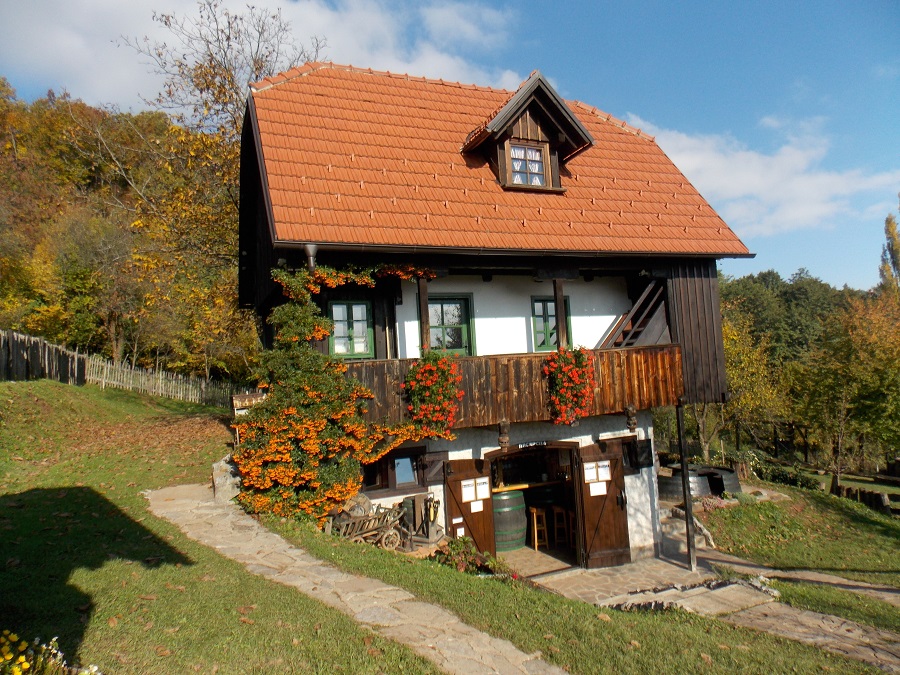
Wine road offers opportunities for wine-tasking in over 30 wineries. These are all about a maximum of 30 minute drive from the Zagreb-Karlovac Highway. Do not limit yourself to sparkling wines – others are great too. If passing at the end of summer, you might also enjoy grape picking, and if later – enjoy Portugieser noir. This is a fresh young red wine ready for consummation very shortly after harvesting. If in a need for a short stop with your camper, you can visit Etno kuća po Okićem, a tiny campsite with a great view of Okić, which also displays a small etno exhibition.
Moslavina
Moslavina is a story of its own. A homeland to two golds – black and yellow ones is slowly making its name in Croatia’s tourism. As the region was once part of the Pannonian Sea, the black gold – oil, was found throughout the region and was a basis for its industrial production for a long time. But its product – a healing oil which exists only in Moslavina and in Azerbaijan is famous for treating psoriasis and rheumatoid diseases which you can do at Naftalan hospital in Ivanić-Grad. The yellow gold is škrlet, an indigenous wine sort which gives fresh citrusy flavour ideal for warm sunny days.
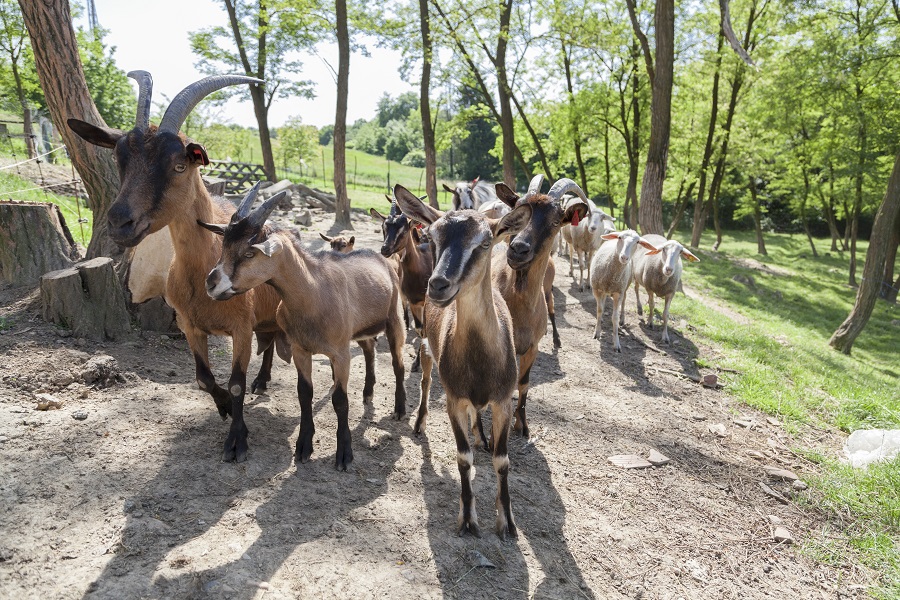
Probably the most famous place to visit in Moslavina and taste škrlet is Kezele family farm. This is open for tourists all year long. Whether you are just stopping for a meal, would like to have a picnic, or decided to stay for several days in nice ethno rooms, the charm of its hosts, the wine cellar, nearby lake, and their animals will make your stay memorable. Food here requires special attention.
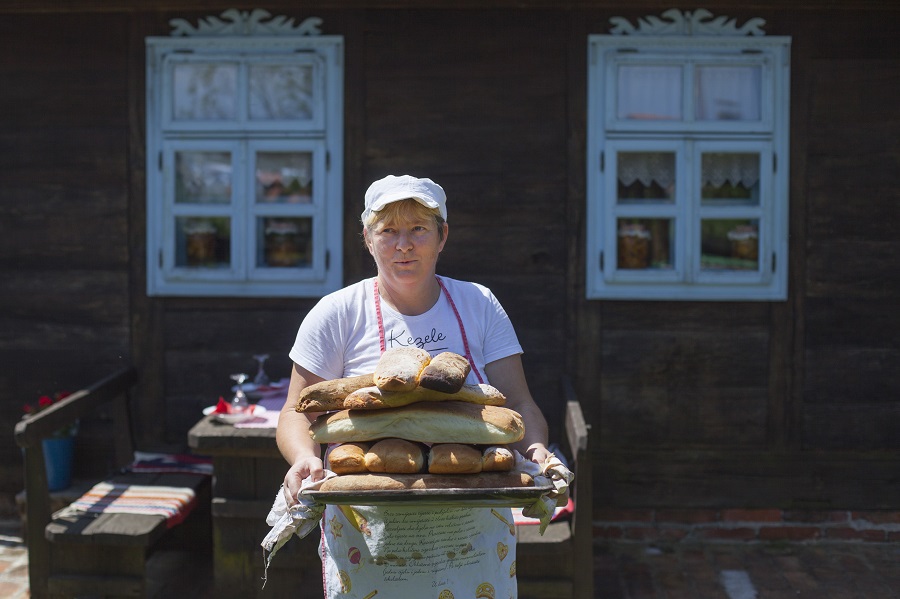
The family’s business originates on kotlovina, a dish made on a metal plate from medieval times. But they also offer a variety of dishes made from locally grown stock and vegetables. Be sure to try ham, cheeses, smoked and blood sausages, game meat, barbecue, and excellent local deserts like strudels. These are common specialties for the entire region, but Kezele’s do them based on old family recipes. You can also buy their wines, rakijas, liquors, jams, and souvenirs at the village shop at the estate. They also provide market space for local sellers.
Lonjsko Polje
A visit to Moslavačka gora, one of the oldest mountains in Croatia is a must as well. It is to become a third geopark on Croatia. Visit also nature park Lonjsko polje – one of the biggest and best-preserved natural flood areas in Europe. Lonjsko polje enjoys a truly special place on the map of European natural wonders. It is one of the last areas in Europe where traditional grazing still exists. Here you can see livestock still roaming freely on large joint pastures.
It also houses the first declared “stork village” in Europe Čigoč. The architecture of its villages resembles old times when two-storied oak wood houses were built without any nails. This was so that they could be easily moved to dry areas during the high-water seasons. Discover the area by foot, bike, canoe, river ferry or boat – it’s only a few kilometres from Zagreb-Slavonski Brod highway!
Prigorje
Prigorje is a small region of the Varaždin-Zagreb highway, famous for its wines. Indigenous Kraljevina Zelina and Kleščec can only be tasted in few wineries. The oldest wine-drinking rules were made in this region, so you need to get acquainted and always follow them. For nice meals, we recommend agritourism Ljubekov gaj close to Zelina (trying Kraljevina from their vineyard is a must) or family farm Rakić, close to Križevci. At both, you can find carefully prepared food using old, preserved recipes, and welcoming hosts – reservation required! At Rakić estate, their love for animals and great hospitality charms many. And you can book to stay at the farm for couple of days.
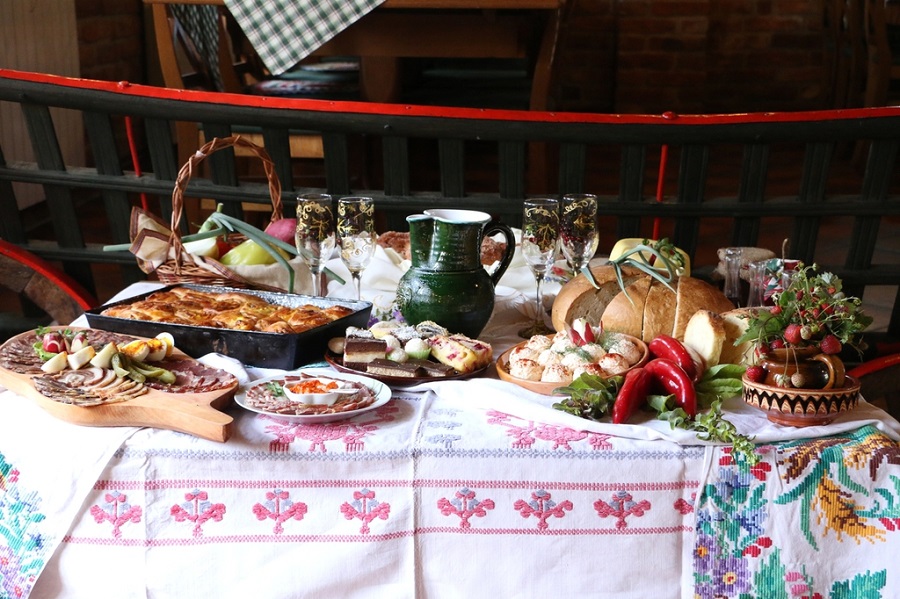
Bilogora is the longest mountain in Croatia and a place for peace and tranquillity. The region bordering Podravina, Slavonia and Moslavina is famous for horses. It is somewhat harder to reach, but its landscapes are marvellous. Stay at rural estate Na Malenom brijegu. This offers simple rooms, great local food, and plenty activities for kids. Although they are most known for different activities related to local legends, newly introduced is the marble playground!

Karlovac region
The area around Karlovac does not have a unique tourist destination name, but it certainly has a lot to offer. Karlovac lies on the banks of four beautiful rivers. As locals say – it may be true that all roads lead to Rome, but all roads also go through Karlovac. We would say almost all, if you are not entering from Italy, Bosnia and Hercegovina, Serbia or Montenegro. Swimming, kayaking, canoeing, and rafting are very popular. You can book your tour in advance and have a short refreshing break here.
The Kupa river is the longest of the four and hides a secret mystery – it is the only river flowing in the very opposite direction, like no other river in the world since its springs in Risnjak, 30 km away from the Adriatic. The Korana river flows out of the Plitvice Lakes which you will most certainly visit, through a canyon with many waterfalls and cascades.
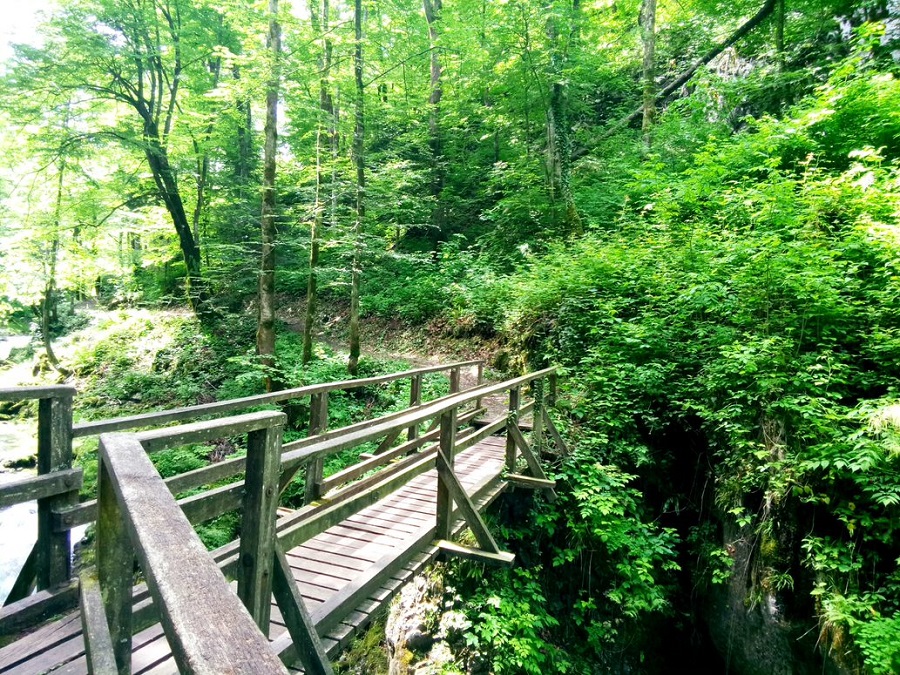
Make sure to visit Rastoke mills where you can enjoy freshly caught river trout at beautiful Slunjčica waterfalls. If in Ogulin area, pay a visit to interesting Đula’s Abyss and Ivana’s House of Fairy Tales. Enjoy a unique multimedia and interactive visitor’s centre which celebrates fairy tales and their makers. If close to Vrbovsko, check out the Kamačnik river canyon and refreshing walks along river banks and amazing wooden bridges. The region is famous for venison and other game meat, river fish, mushroom dishes and tasty desserts made from wood berries and chestnuts. Strudels are highly recommended as this is already an entrance to Gorski kotar mountain range.
Lika
When you notice that temperature at your car’s thermometer starts falling, it is time to get out and enjoy the fresh air and a completely different Croatia. Connecting Central Croatia and Adriatic coast, the mountain ranges of Lika are home to three national parks: Plitvice lakes, North Velebit, and Paklenica and Nature park Velebit which all host protected flora and fauna and offer magnificent sceneries and experiences. Hike and cyclee on marked routes throughout the region whilst you can also enjoy rafting and kayaking at Gacka river.
Kuterovo and Plitvice Lakes
In Kuterevo, visit the shelter for young bears, explore the mills on Majerovo Vrilo, a source of the river Gacka, and in Krasno the House of Velebit visitor centre. Caves are a must see – Cave park Grabovača and Barać caves are open every day – book your tour on time! Plitvice Lakes are the most famous gem of this region and dreams for your luxurious glamping can me met at Plitvice Holiday Resort, either in tree or lake houses, mobile homes, or deluxe tents. There are also plenty rural houses and apartments where hospitable hosts are waiting for your longer stay.
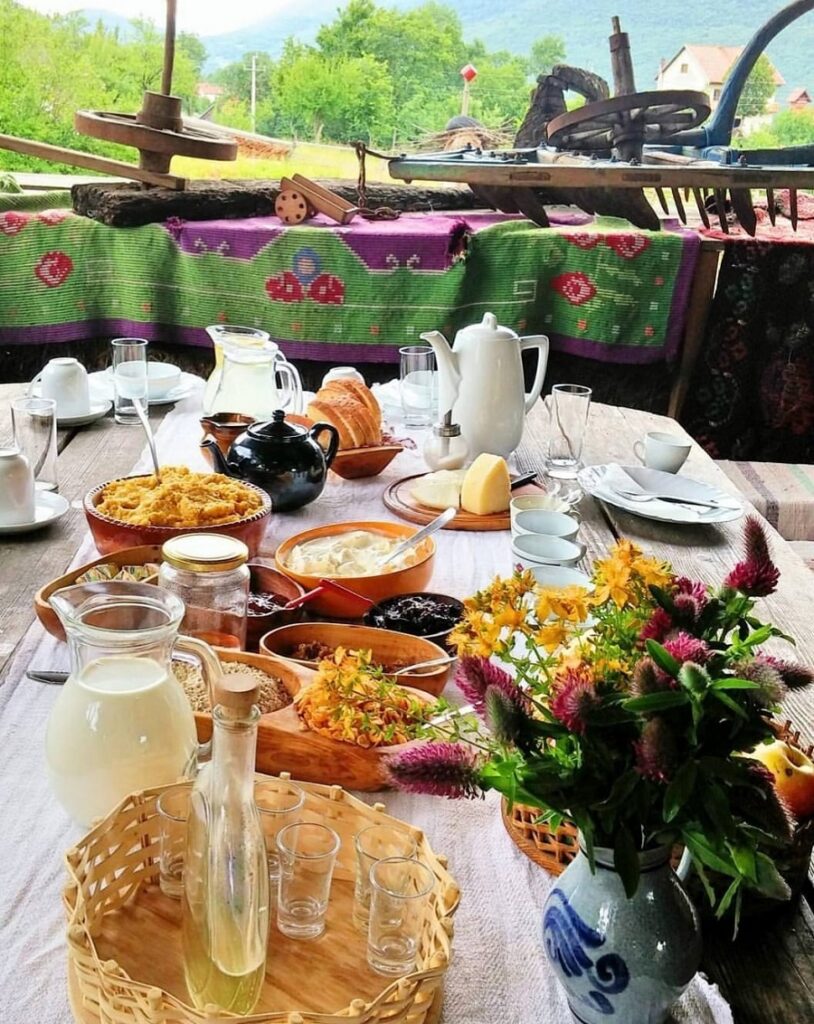
They will tell you a lot about the history and treasures of this region after welcoming you with local rakija. Lamb, goat, river fish, smoked meat, cabbage, potatoes, and dairy products are a basis of their simple cuisine which will leave its tastes in your mouth long after you depart. Try local cheeses such as škripavac, sheep cheeses and basa. This is soft cow cheese made in the old-fashioned way, delicious cicvara (type of porridge) from cooked polenta in milk and butter, fresh, marinated, or smoked trout or caviar, and venison specialities. The best desserts, like strudels are made from local berries, so not to be missed. As locals say here – Lika is not a stop-by station, it’s a destination!
Lika is the birthplace of electricity as Nikola Tesla did his first experiments in the region. So a visit to the Memorial Centre “Nikola Tesla” in Smiljan is also a must. It is about 10 minutes’ drive off the highway to Split. Explore how Tesla’s early discoveries brought benefits to modern life and see more than 900 of Tesla`s inventions. And breathe some fresh air!
Kvarner
A beautiful mixture of Gorski Kotar highlands and an entrance to the Adriatic with Krk, Cres, Lošinj, Rab and many other smaller islands.. Risnjak National Park and Učka Nature Park are both magnificent nature reserves offering various forms of recreation year-round. Don’t miss numerous educational and hiking trails with astonishing views: the Trail of Predators – the wolf, the bear, and the lynx in Tršće and Fužine, Fruits of the Mountains in Ravna Gora, the Bear Trail in Brod na Kupi, and Vražji Prolaz (Devil’s Pass) and Zeleni Vir (The Green Whirlpool) in Skrad.
Cres and Lošinj
If on Cres, visit Beli Visitor Center to see how griffon vultures are been taken care of. Looking to buy souvenirs and supporting sustainable tourism, make sure you buy a local craft produced from sheep wool. If on Lošinj – you may try swimming with dolphins in the crystal-clear sea. If you are already in the region, you know that there are more than 1300 km of marked bike paths. Windsurfing is especially attractive for those eager for adventure, with the best locations in Baška on the island of Krk. Hang-gliding and paragliding can help you to enjoy beautiful landscapes. And snorkelling and diving in exploring the underwater situation. This is how ancient Apoxyomenos, a masterpiece of Croatian and world cultural heritage, was found. You can visit in the Mali Lošinj museum.
Kvarner culinary specialities
The cuisine is a combination of continental and coastal cuisine. Alongside with first-class fish, crustaceans, the largest Adriatic prawns, and other seafood, do not miss the food from the forest – mushrooms, wild berries, ”maruni” chestnuts, and game meat will definitely bring interesting tastes. Lamb from local farmers is a hit, particularly on Cres, Krk, and Rab. Some of the best cheeses in Croatia, from cow’s, goat’s and sheep’s milk from the mountains, the coast, or the islands, are made here, as well as the famous and protected Krk prosciutto and olive oil. You can taste all of those in local restaurants, agritourism’s or tasting places. Srudels made from freshly picked wild berries are tempting in Gorski Kotar, and the traditional Rab cake if on Rab. It has a rich history – check it out.
There are many wine tasting estates open for visitors where winemakers will welcome you for tasting and pleasant conversation. The most famous wine variety is indigenous žlahtina, a white sort which grows on the island of Krk. The žlahtina of Vrbnik is held in particularly high regard. Other indigenous sorts such as belica, jarbol, trojščina, and gegić are in high demand. But the other more famous varieties including merlot, white muscat, cabernet sauvignon, chardonnay, and pinot noir, gris and blanc will definitely satisfy all wine lovers. After a visit, you might want to take the smells and tastes of Kvarner – home.
Istria
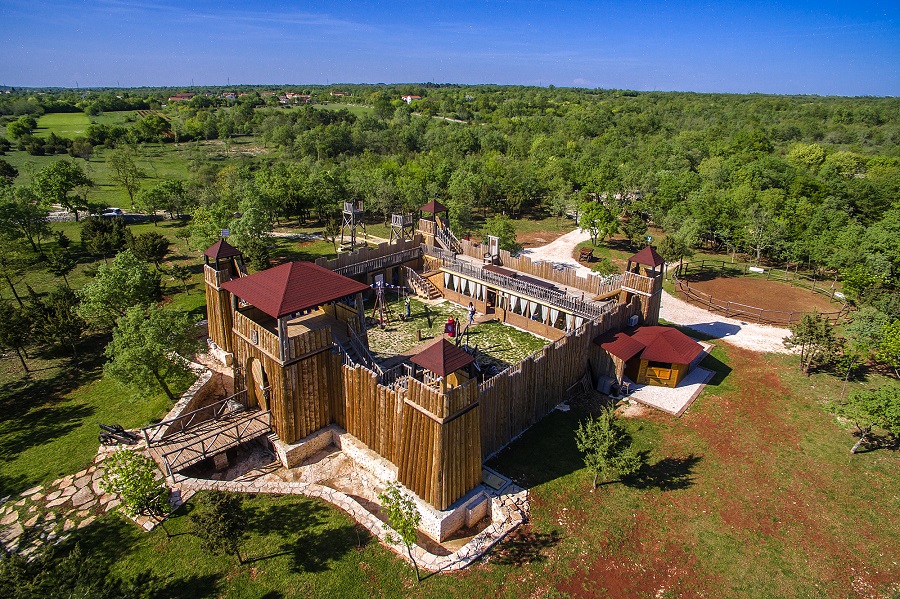
Everyone goes to the wonderful Istrian coast and Brijuni National Park, some visit continental medieval towns such as Grožnjan, Pazin, Motovun, Hum and others, but rare visit true rural Istria. And this is changing!
There are many hidden gems to be discovered in rural Istria any time of the year. Simply driving or cycling (extremely popular these days) through olive groves, vineyards, gardens, fields, pastures, and forests will give you positive energy of green Istria. For longer stays, there is a myriad of rural accommodation facilities, such as renewed old stone villas, or the new ones and many of them rather luxurious. Looking for the real rural Istria? Then book those which are based on agricultural estates.
World’s best olive oil
Istria is the world’s best region for producing extra virgin olive oil so you can find out why. Apart from olives and olive oil, rural Istria is famous for home made pasta, truffles, asparagus, boškarin beef, and its wines. For breakfast or brunch, try a fritaja (a variety of omelette). This is made from local eggs with local seasonal ingredients such as asparagus. Only here can you try the unique Istrian “supa”, a mix of red wine, olive oil, salt, pepper and toasted white bread that villagers used to eat for strength or to recover after a period of illness – a proven elixir for the whole day!
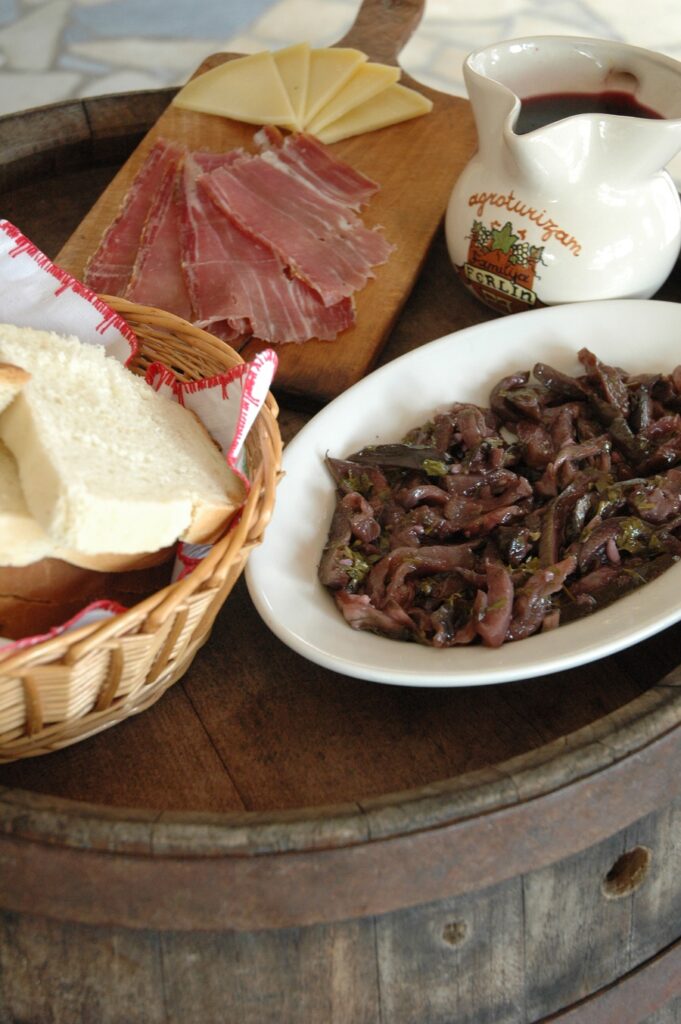
Another soup to try is maneštra, made with local vegetables. Lunch or dinner usually starts with a glass of biska, medica, or rakija with common rue or a glass of Muscato or natural juice. Appetisers include sheep, cow or goat cheese, Istrian prosciutto (protected), bacon and sausages, which are mostly dried in the bura wind that blows here.
Handmade pasta such as pljukanci, posutice, ravioli, njoki, and fuži go well with the sauce of boškarin beef, venison, home-reared chicken, asparagus, truffles, or vegetables. Truffles? Istrian ones are the biggest in the world. And there are few famous places where you can taste and buy them. Of the meat dishes, you must try ombolo and sausages with sauerkraut, žgvacet (goulash made from pieces of chicken, beef or venison in a thick sauce), and delicious dishes made under the bell, called “čeripnja”, or in a bread oven.
Istrian desserts
Try to leave some room for desserts! Fritule, kroštule, pandešpanja, povetica, bucolaj, pince (around Easter), breskvice, paštine, and cukerančići, which go wonderfully with Istrian dessert wines. For a taste of real pasta combined with meat and fresh local ingredients, we recommend a visit to Agrotourism Ferlin Family, Agrotourism Tikel, Agrotourism Dol and numerous other agritourism estates, reservation preferred. Your hosts will recommend what you should have from their own produce – take the advice!
The indigenous grape varieties – Istrian Malvasia and Teran – are the most popular for wine making. But lesser-known ones such as refošk and sansigot are growing in popularity. And you can only drink them here. The doors of wine, cheese, truffle and olive oil tasting facilities are wide open during the tourist season. These are either on marked wine and olive roads or slightly off the beaten path. You can also taste these delicacies in numerous taverns, restaurants, and hotels in the interior and on the coast. Always check for availability and make sure to buy a few of these products to take home!
Nature parks
Besides the famous National Park Brijuni, make sure you pay a visit to Nature park Učka and Ćićarija mountain for hiking and beautiful sceneries of Istria and Kvarner. You can see Italy from here as well! The Seven Waterfalls trail starting in Buzet is a bit difficult, but definitely worth exploring as Mirna river provides unforgettable sceneries here. If you like caves, Istria has a lot to offer. Mramornica, Baredine, Pazin, Kingdom of Festini, and Romuald’s Cave can all be visited throughout the year, with advance reservation. Istria is a cradle of legends which is particularly interesting for children. Do not miss paying a visit to the Medieval Theme Park Sanc. Michael where they can enjoy escape rooms and numerous games from old times in a hand -made wooden medieval castle.
Dalmatia
The same as for Istria, if you are bored at the beach, or simply want a quiet Mediterranean vacation, visit continental, mostly rural Dalmatia!
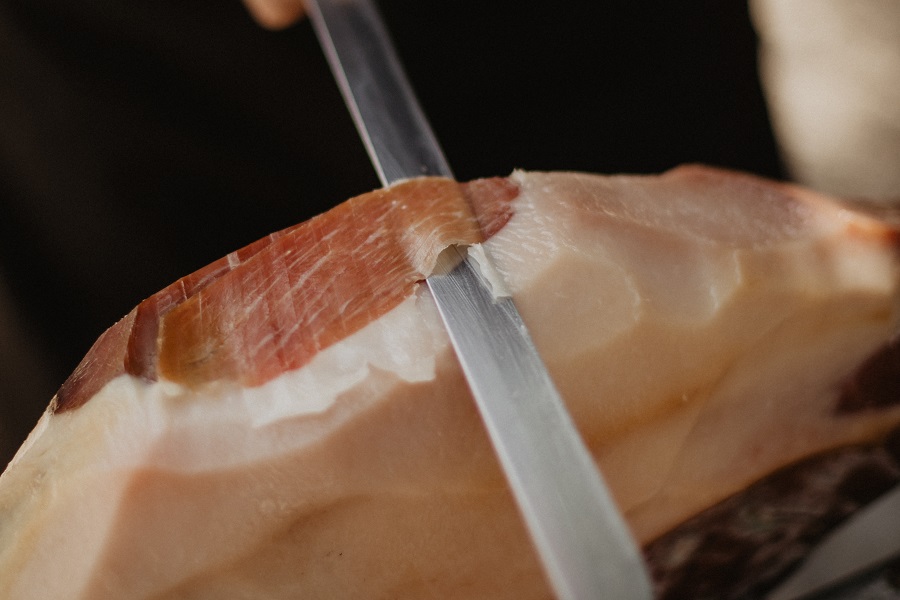
Starting from Zadar, Šibenik, Split, Dubrovnik and other coastal and island cities’ surroundings, the rural areas are a homeland of Croatia’s rich history, excellent wines, rakijas and liqueurs from local fruits, olive oils, cheeses, prosciutto and many other agricultural products that you are likely to taste while in the Southern Croatia. In Dalmatinska zagora, Konavle, and on numerous beautiful islands there are many agricultural estates offering accommodation.
Accommodation and activities
Many old houses and ethno villages have been renovated. Additionally, many new villas and apartments are available to ensure your pleasant stay at Dalmatian villages. If you would like to avoid the high season, we recommend you come in spring or autumn for a longer stay. Fresh air with nice smells of Dalmatian plants, peace and locally grown food are good incentives for a short- or long-term visit to the rural Dalmatia. Numerous tasting facilities for wine, olive oils, cheeses, honey, and other products are all over the region.
Dalmatia offers plenty opportunities for active vacation. These include hiking, rafting, canoeing, kayaking, wind and kite surfing, jeep safaris, scuba-diving and other. The region hosts three national parks: Kornati, Krka and Mljet, nature parks Biokovo, Vransko lake, Telašćica, Lastovo, and Dinara, and Geopark Vis archipelago. There are numerous hiking trails and cycling routes and a lot has been invested here on marking and safety. Get acquainted with each of those in advance to avoid being rescued by the locals. Apart from its nature and a newly opened Skywalk, Biokovo is particularly known for visitor rescues.
Besides the excellent sea food, there are many other local dishes that can take you to Dalmatia’s culinary history where many different cuisines have met.
Zadar
In Zadar area, make sure to taste Pag cheese, the most awarded cheese in Croatia, soaked in the flavours of Mediterranean herbs and salt, as well as Pag lamb. Meat delicacies such as Iž lopiž – a meat dish cooked in traditional clay pots and Nin šokol – dried pork collar dipped in red wine from around Benkovac are a great choice. In terms of drinks, try esteemed maraschino liqueur Made from Maraska sour cherries. Around small idyllic towns and villages, numerous families produce top-quality wines, so take the wine route in Ravni Kotari learning about maraština, crljenak, debit, and plavina, as well as wines from famous varieties such as zinfandel, merlot, cabernet sauvignon, and syrah. On Pag, be sure to try the native gegić.
Šibenik
In Šibenik area, the meal usually starts with a glass of home-made rakija made from cherries, pears, figs, blueberries, walnuts, jujube, and rose petals or the aromatic travarica with a truly unique herbal taste coming from many different plants. Absolute musts are autochthonous cheese “iz mišine”, ripened in lambskin, as well as Drniš prosciutto. Unlike the northern Adriatic region, here prosciutto is smoked, which makes it very special.
Main meat dishes to try are arambašići, lamb under the bell, kumbasice, and unique Skradin risotto. It takes more than 10 hours to cook it and it is traditionally prepared by men. Skradin area also offers a unique Skradin cake – a mighty treat that was once served to newlyweds on their first wedding night. Other desserts like bruštulani (candied) almonds, figs and sorb apples are sure not to disappoint! Top quality wines here are made from the red varieties babić, lasina, and plavina. The white varieties debit and maraština are somewhat less common but certainly worth tasting, as is the dessert wine prošek. If you are up for a longer stay with nice hosts, we recommend a stay at Agrotourism Kalpić close to National park Slapovi Krke.
Split
In Split area, before meals we recommend liqueurs made of myrtle, laurel, and sour cherry, or the home-made rakija brandies – travarica, orahovica, rogačica, or smokovača. Dalmatian prosciutto and sheep cheese are indispensable as an appetiser or with wine tasting. In the hinterland, be sure to try the crayfish from the Cetina, Sinj arambašići, frog brudet, soparnik, pulestar – young rooster under the bell, and koštradina – cured mutton with collard greens or sauerkraut on cold days. On the island of Vis, be sure to try the Komiža pogača made with locally grown tomatoes and salted anchovies or sardines.
Olive oil is an ingredient used in almost all dishes, and you can experience traditional production and top-quality tasting at the Olive Oil Museum on the island of Brač. Some of the grape varieties grown in this region are either related to or served to develop world-famous wines, such as the Californian Zinfandel. In numerous wineries and tasting rooms, you can taste wines from indigenous varieties such as tribidrag or crljenak kaštelanski, grk, plavac mali, pošip, and vugava. Dessert lovers should reserve some space for sweet rafioli – from Imotski or Makarska region, paprenjaci, the padišpanj cake of Trilj, or the hib made of figs and almonds with aromatic herbs.
Dubrovnik
In Dubrovnik area, make sure to visit Pelješac, Konavle, Elaphite islands, and the Neretva river delta.
Make sure to try Konavle cheese preserved in olive oil and other cheeses in the region made from various types of milk. Try indigenous specialities such as green manestra, šporki makaruli, the Neretva eel and frog brodet, lamb pikatić, tripice, young goat meat or lamb under the bell or spit-roasted, and cooked meat called lešada. For desserts, arancini (candied orange, grapefruit or lemon peel), kontonjata or quince cheese and mantala – cake made from red grape juice, Dubrovnik rozata, almond krokant (brittle), sponge cake pandišpanj, and Ston macaroni cake are highly recommended. The wines rank among the most prized wines in the world.
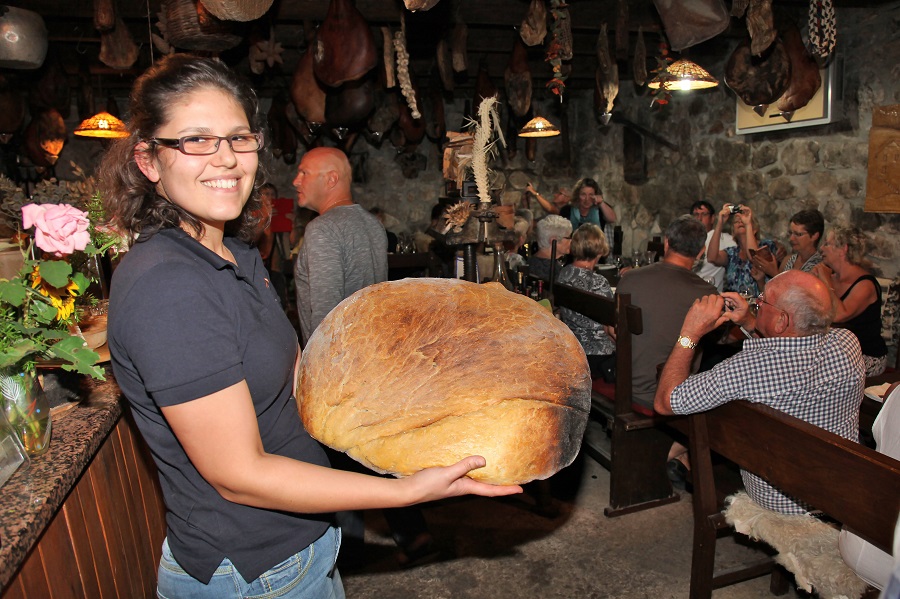
The barren Dalmatian karst of the Pelješac peninsula is home to top-quality plavac mali from the wine-growing slopes of Dingač and Postup. The most famous white variety is the Dubrovnik Malvasia, but make sure to try wines from the indigenous sorts such as grk and pošip from Korčula and the Konavle variety kadarun. If you want to stay at a real Dalmatian farm, visit Agritourism Antunović on Pelješac, where the four generations are hard working on their land to offer tasty specialties in their konoba. They are famous for donkey milk, and you can try milking the donkeys at the farm.
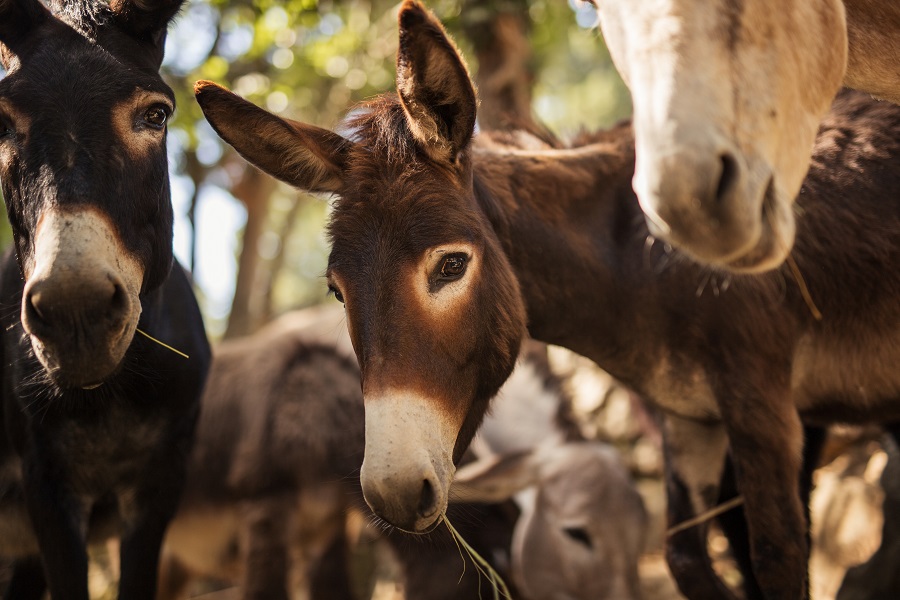
As mentioned at the beginning – rural Croatia has a lot to offer – consider experiencing a different side of Croatia!
Croatian Rural Tourism in a Page was compiled in association with the Croatian Rural Tourism Association.

